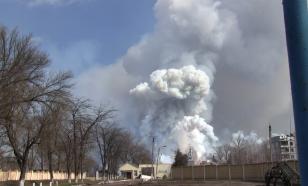Memories of Soviet actor Aleksandr Pavlovich Antonov
by Olivia Kroth
Aleksandr Pavlovich Antonov died on the 26th of November 1962, fifty years ago, after a lengthy career as actor in Soviet films and on stage, stretching from the silent era to the 1950s. His best known role was that of Grigory Vakulinchuk in Sergei Eisenstein's famous film "Battleship Potemkin."
The actor was born on the 13th of February 1898 in Moscow, where he later started to work as a member of the ensemble at the Proletcult Theater, a theatrical branch of the Soviet cultural movement "Proletcult." It was concerned with the powerful expression of political content in theatrical form, following the Revolution of 1917.
Proletcult promoted a culture of the factory floor, but also folklore and avant-garde. With unusual lighting techniques, props, slogans and circus elements, it attempted to affect the audience emotionally and psychologically in order to make the viewers aware of the conditions they were living in.
It was at the Proletcult Theater in Moscow that film director Sergei Eisenstein (1898-1948) detected Aleksandr Antonov. The genial film director was a great admirer of the Proletcult theory. He continued many of the experimental elements of this theatrical form in his films.
Sergei Eisenstein cast Aleksandr Antonov in "Strike" (1924) and "Battleship Potemkin" (1925). "Strike" is a silent film of 82 minutes length, showing striking factory workers in the pre-revolution year 1903. The strike is brutally suppressed by tsarist military.
The most shocking sequence is the violent put down near the end, cross-cut with footage of cattle being slaughtered. While workers are driven into a field by the army and shot en masse, the public sees alternating scenes of a cow being killed. The animal metaphor is stronger than words could ever be.
The film opens with a quote by Vladimir Lenin: "The strength of the working class is organization. Without organization of the masses, the proletarian is nothing. Being organized means unity of action and unity of practical activity."
The viewers see, however, that the organized proletarians of this particular factory are not strong enough to carry out their strike successfully. Although the film remains silent, we can hear the revolution grumbling, getting louder in Sergei Eisenstein's next silent film, "Battleship Potemkin."
Between the production of "Strike" and the film's premiere, Sergei Eisenstein wrote his influential essay on film theory, "Montage of Attractions." He became world famous as the father of film montage, a sequence of conflicting images, with the cumulative emotional effect of a scene greater than the sum of its parts.
Aleksandr Pavlovich Antonov plays a member of the factory workers' strike committee in "Strike." One year later, in "Battleship Potemkin," he will be cast in the role of the Artillery Quartermaster, Grigory Meketovich Vakulinchuk (1877-1905), a Ukrainian sailor in the Russian Navy who took part in the mutiny of the crew on the Battleship Potemkin.
This historic person was born as one of nine children in Velki Koroventsi. He and his family worked in a sugar factory, until the navy conscripted him. As a conscript, he became a member of the sailor patrol in Sebastopol, a radical revolutionary group. On the Battleship Potemkin, he took part in the Black Sea uprising in 1905.
During the fight, he was shot in the chest and fell overboard, but was saved and sent to the infirmary. He did not survive, though. On his deathbed in the hospital, he asked for his savings, 80 roubles, to be split between his father and the comrades on the Battleship Potemkin.
His funeral in Odessa turned into a political demonstration. The most dramatic scene of the film is placed towards the end, when the tsarist army marches down the steps towards the harbor of Odessa, shooting at the demonstrators. The public sees shattered glasses, a woman's mouth wide open in fright, a baby pram careening down the stairs and black soldiers' boots marching in rhythmic movement.
The silent film "Battleship Potemkin" speaks loudly, thanks to the montage technique which provokes strong emotions. The film aims at drawing the public in on the sailors' side, sympathizing with the suppressed and hating the oppressors.
The people in this film are shown as types rather than individuals: beggars, children, mothers, sailors, officers and aristocrats. Only Grigory Vakulinchuk is an individual, played memorably well by the actor, Aleksandr Antonov.
He is the only three-dimensional character. The other human beings are deliberately shown as masses of men, moving in unison, the sailors, as well as the tsarist officers. The people of Odessa are a mass, too, consisting of briefly glimpsed faces.
A film poster shows Aleksandr Antonov in sailor's uniform, wearing a white cap with the word "Potemkin" on his head. His bushy eyebrows, dark eyes and black, trimmed moustache bear some resemblance to the historic person, Artillery Quartermaster Vakulinchuk.
The silent film of 70 minutes' length had its premiere at the Bolshoi Theater in Moscow, on the 21st of December 1925, as official film for the 20-year jubilee of the Revolution in 1905. It was later distributed by Goskino and became Sergei Eisenstein's most famous film, a classic.
In the 1950s, the British cinema magazine Sight & Sound named it "the best film of all times." In 1958, "Battleship Potemkin" was chosen again as "best film of all times" at the Brussels World Fair.
The sequence of the Odessa steps, with the boots marching, the people being shot at, seems to be unforgettable and was later varied many times, in homage to its author, Sergei Eisenstein. The following film directors took it up in their own work:
Terry Gilliam in "Brazil," Brian de Palma in "The Untouchable," Tibor Takacs in "Deathline," Laurel and Hardy in "The Music Box," George Lucas in "Star Wars Episode III: Revenge of the Sith," Chandrashekhar Narvekar in "Tezaab," Shuko Muraze in "Ergo Proxy" and Peter Sellers in "The Magic Christian."
The Irish painter, Francis Bacon (1909-1992), was profoundly influenced by Sergei Eisenstein's images, particularly the nurse's broken glasses and open-mouthed scream. This motif later appeared in his "Abstraction from the Human Form" and in "Fragment of a Crucifixion."
Actually, the massacre on the Odessa steps never took place in reality, but was inserted by Sergei Eisenstein for its dramatic effect, showing the brutality of the tsarist regime. This scene is probably the best example of his theory of montage, using juxtaposition and dialectical cutting: point, counterpoint, fusion.
The film director felt that montage should proceed from rhythm, not from story. Many cuts are abrupt, in an aggressive, insisting approach. The framing is also experimental, with its stark contrasts of light and dark.
The film's silence constitutes a vital element. It demonstrates the importance of visual information, showing that most human communication is non-verbal. Human body language is always silent.
"I am accused of making Battleship Potemkin too emotional," Sergei Eisenstein wrote, "but are we not people? Don't we have human feelings? Don't we have passions? Don't we have our own tasks and purposes in life?"
Film director Sergei Eisenstein's task and purpose in life was to bring the message of working class power to a mass audience and to make Soviet cinema immortal, while actor Aleksandr Antonov's task and purpose in life was to contribute to this film in the role of the Artillery Quartermaster.
As Grigory Vakulinchuk, he cries out loudly at the shooting officers, "Brothers! Who are you shooting at?" A memorable line indeed, of timeless quality. In every war, even today, victims may shout, "Brothers! Who are you shooting at?"
Thus, "Battleship Potemkin" has become one of the fundamental landmarks of cinema, and Aleksandr Antonov contributed his part to this timeless creation of a Russian genius, Sergei Eisenstein.
Afterwards, he played in one or two films per year until 1956, but never reached the artistic height of "Battleship Potemkin" again. Of the 50 films he made, his second film was by far the best.
Aleksandr Antonov stopped working in 1957, the year which became famous in Soviet history for its first satellite being launched, Sputnik 1. One year before the actor died, he could witness the first Russian cosmonaut flying in space, Yuri Gagarin.
As life moves in never ending spirals, older ones go, young ones are born, all of them woven into the web of Russia's history and traditions, a country that is strong because of its strong people, full of creative spirit, imagination and magic.
Thus, Russia will always remain a great nation with great people of great talent.
Prepared for publication by:
Lisa Karpova
Pravda.Ru

Subscribe to Pravda.Ru Telegram channel, Facebook, RSS!


